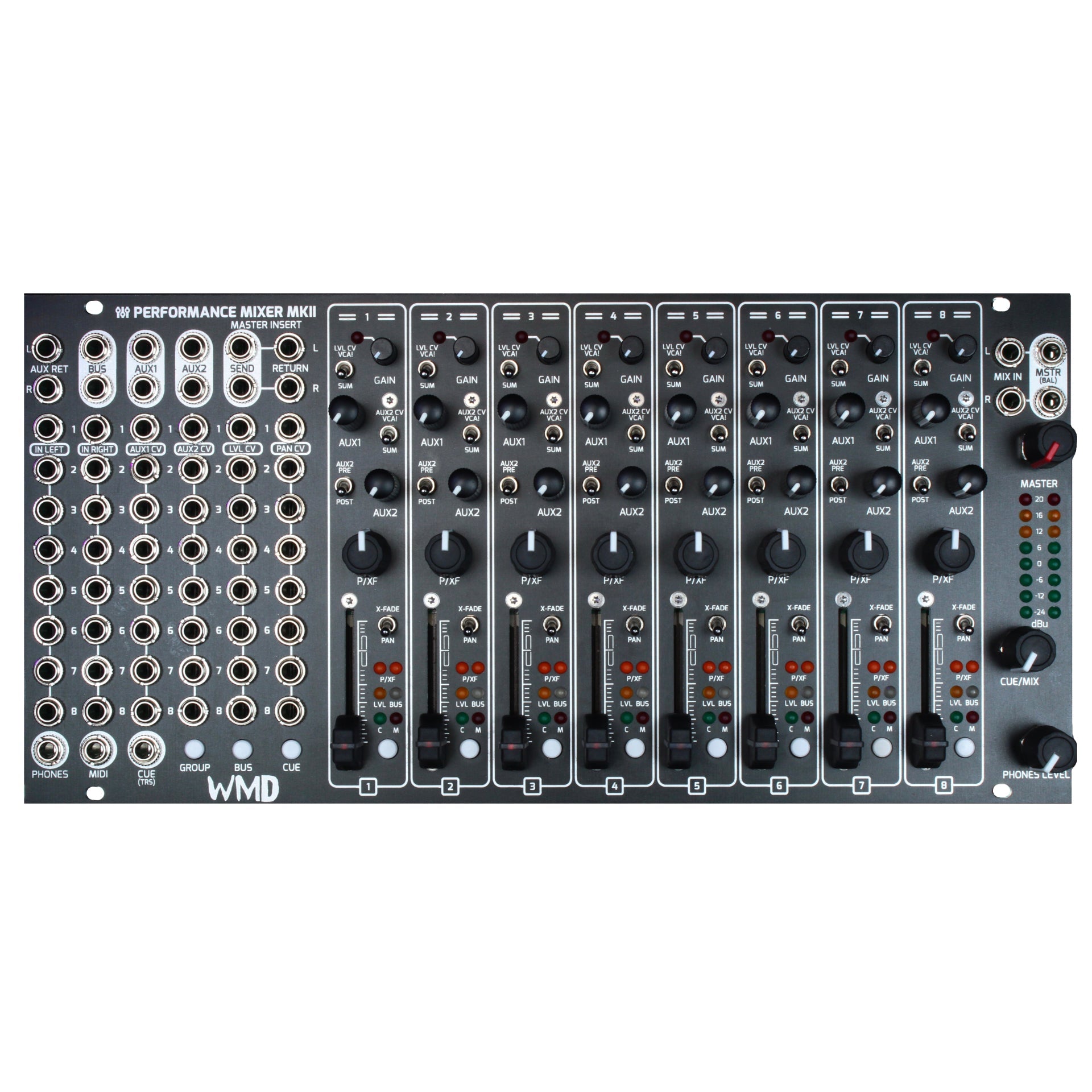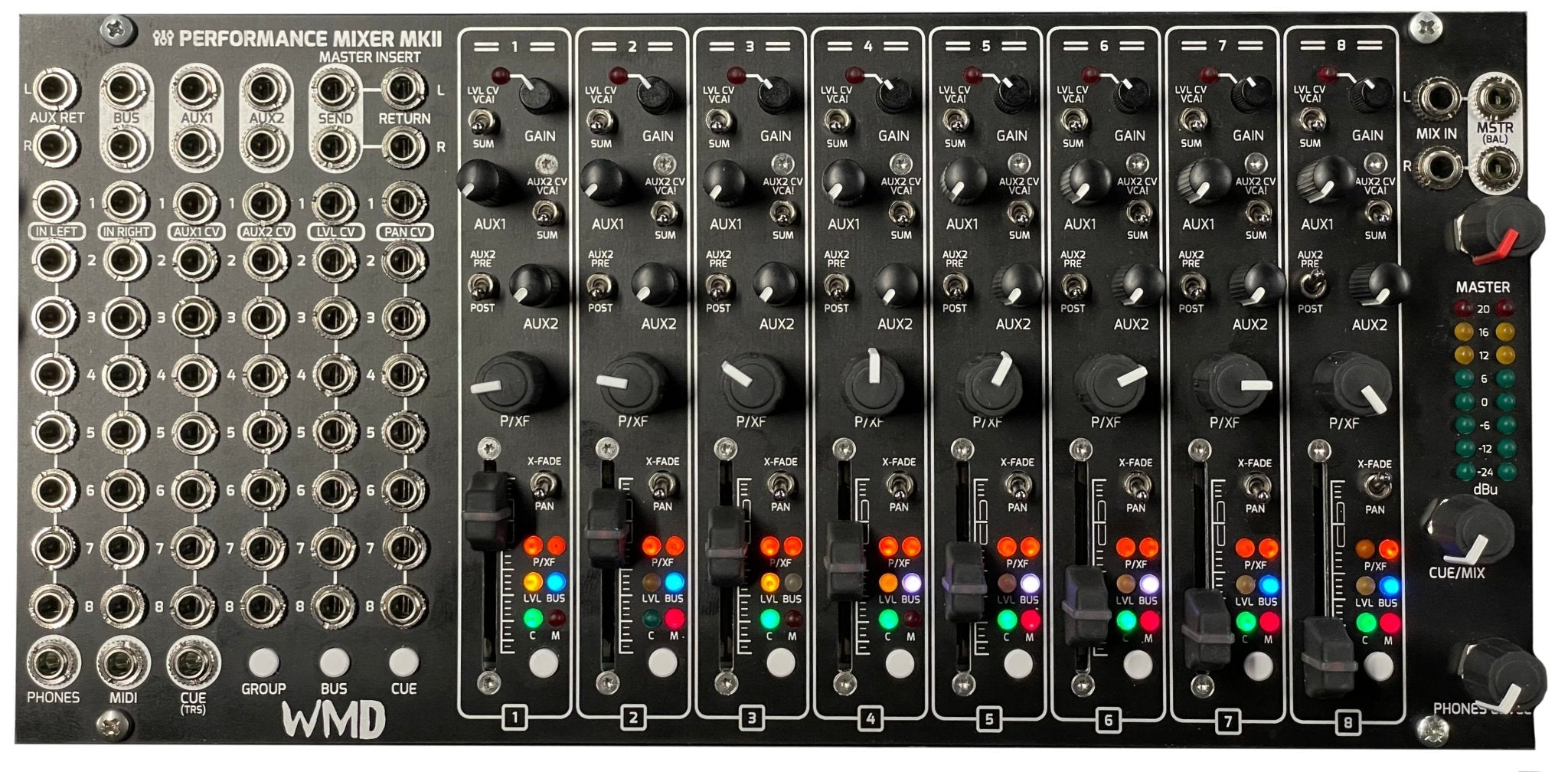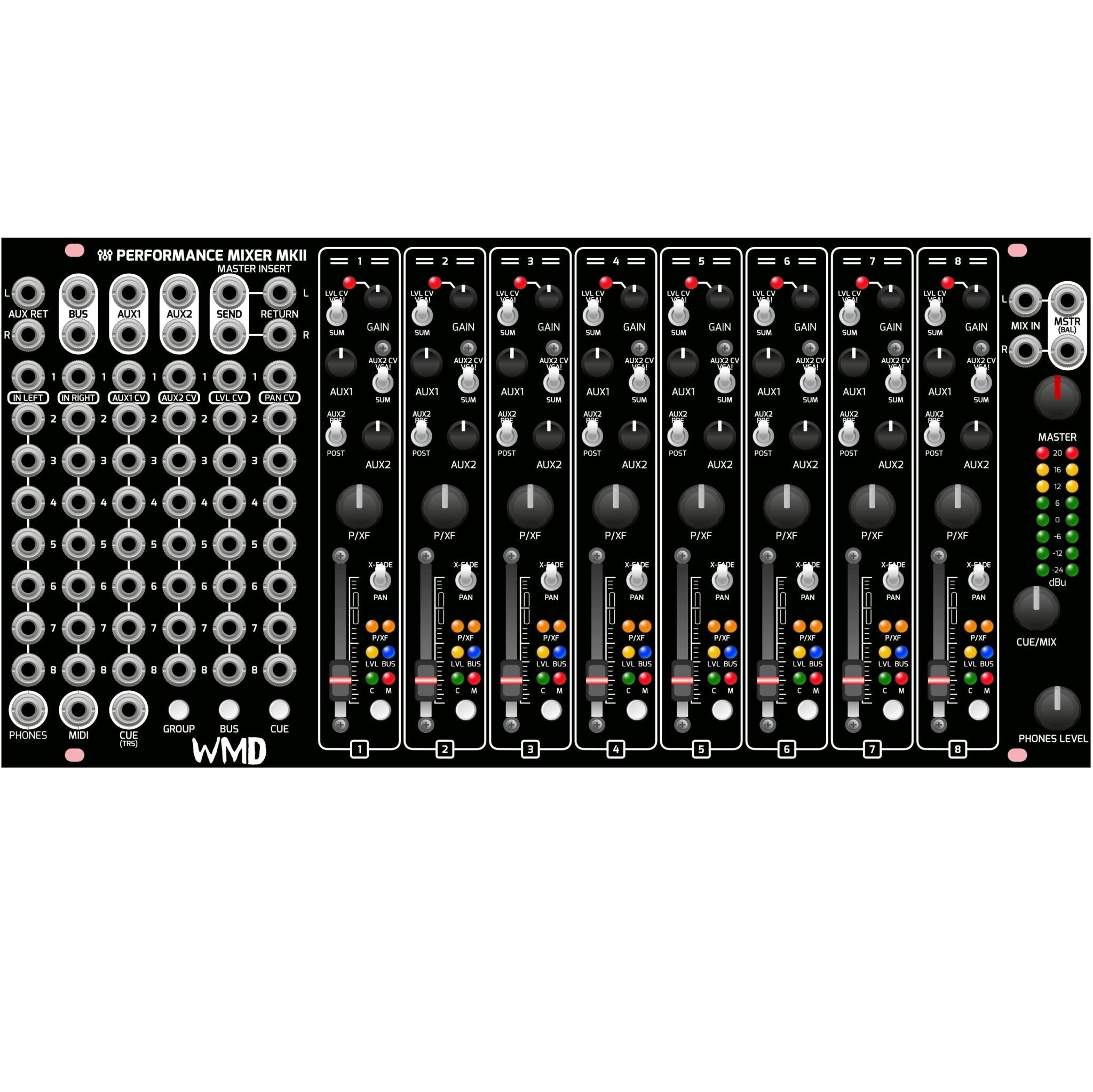


Performance Mixer MKII
Professional 8-channel stereo mixer with major upgrades from original. Features replaceable channel strips, crossfader/pan per channel, dual AUX sends, stereo cue bus, and group recall functions. Improved noise performance with 8-layer PCB design. Modular expansion supports up to 24 channels with PM Channels MKII units. Includes balanced outputs, master insert loop, and headphone monitoring. Perfect for live performance and studio recording with intuitive workflow.
Pairs well with

Performance Mixer MKII
Latest Update
New production run underway
Product Details
Here is a Multitrack Recording Guide for use with the DB25 MKII
Preorder Information:
Preorders are open for the second production run. Modules available in the preorder: PM MKII, Returns, DB25 MKII, Direct Outs, PM Channels MKII
International Preorders: Please check with your favorite dealer so they can order from us.
Brief History:
Enter the WMD Performance Mixer MKII - Nine years after the MKI was released, the MKII builds on all the valuable feedback we've received. This is a serious upgrade, with feature enhancements and engineering improvements affecting every bit of the design.
The original Performance Mixer changed the eurorack landscape when it first came out, it made mixing much more intuitive and instant, it allowed people to ditch the heavy outboard mixer, and keep their system patched while they traveled. It made using individual drum modules and multiple voices easy to keep straight in a packed dark room. We know this because you all wrote us with praise, and with suggestions to make it better. Almost all of those suggestions have been engineered and are in the new unit, plus a few features that push the concept further.
Thank you for your support, trust, and patience for us to deliver this newly designed mixer. It's the most advanced and complicated thing I've ever designed, and it's taken several years to get ready for the world to see.
Decisions, decisions, decisions!
If you recall, we showed a previous version of the PM MKII a year ago. That version was very similar to the original, with a few enhancements. Primarily focused on manufacturability and overall noise floor with some great recording features. We moved to an 8 layer board, replaceable channel strips, developed the MIDI and bootloader, pre/post fader headers, and made it work on both AUXs simultaneously.
I sat on that design for a while after showing it. That version (Rev E) was done and could've been sent to production, but I didn't feel good about it. The improvements made it more expensive, but the feature set wasn't there, but it was really fun to play on, and worked well, but it was missing the big leaps that would justify the cost increase. So I went back to the drawing macbook and redesigned and drew up ideas until I landed with this mixer, (Rev G) that went to prototype after a year of revision. Here's riffing on a few of the improvements that make the final MKII worth making.
- Noise Performance - The MKI was alright with noise, there was a little bleed too. Going to 8 layer boards meant I could put ground planes between trace layers, and spread the traces out triple the spacing of what they were on the MKI, this reduces bleed/crosstalk by a factor of about six.
- Noise Performance 2 - On the Original, the Level VCA was before the Panning VCAs, which saved on parts/power, but it meant that the Panning VCAs were always connected to the mix bus, adding noise floor that couldn't be attenuated. Making all the channels stereo and putting the Pan circuit first eliminated this problem, now the noise add is controlled by the fader. This did force me to make every channel stereo, so the design got simpler through figuring this out.
- Panning / Crossfader - The above panning/level improvement made it possible to convert the Pan control into a crossfader, buy simply routing the post pan signals through a switch to the opposing channel, summed at the Level control. This huge improvement allowed the A/&/B input switching scheme to still work on the PM MKII, a bit differently, but its there in spirit.
- Modular Design - The channel strips are all now stereo, and identical, which makes assembly much easier, and lowers the cost. It also makes replacing them easier should a mechanical part fail or get spilled into. Further, the Patchbay, Power board, and Master section are all separate parts, so if there's a failure, they can be quickly swapped without having to RMA the whole unit.
- Patchbay - The MKI and rev E MKII still had jacks misaligned with channels. This was a source of frustration for myself and many users of the PM MKI. And I decided to just be done with it. It didn't make sense to try to put jacks over the channel, it wasted too much space on the panel... So all the jacks go left, keeping the mixer clear of cables, this let me space the knobs out a bit to take up all 3U. It's cleaner, simpler to make, and intuitive to use.
- Expandability - It's super modular now, the DB25 can connect to any two headers that spits out audio, they're all the same format across PM MKII and Channels MKII. Pre, post, mixes, connect it however you want. And the connectors can't be hooked to power, meaning no more blown opamps and RMAs to the factory. They're all shrouded too so they won't get bent in shipping!
Features Overview:
Everything is stereo. Inputs, Busses, Auxes, and Cue Mix.
INPUTS: IN LEFT is normaled to IN RIGHT.
GAIN: Each channel has a Gain trim range of -12dB to +20dB, this will let you use line level devices easily.
GAIN CLIP LED: lights red 1dB before clipping the input stage.
LVL FADER: smooth intuitive curve for easily adjusting the mix level on the fly. A yellow indicator shows the level.
MUTE: Press the channel button and the channel will soft mute with a red LED indicator.
PAN: with the toggle switch in PAN mode, a nicely curved pot will allow you to place your source where you want it across the stereo field.
X-FADE: set the toggle switch to X-FADE and the PAN pot becomes a crossfader for the left and right inputs. The signal is then sent dead center to your mix bus. This is ideal for kicks and bass, and lets you route more than one input to a single channel. Pan/X-Fade positions are shown on two orange LEDs. CV sums with the pot.
LVL CV: this toggle switch is normally down in SUM mode. Flip it up to VCA! mode and the channel fader becomes an attenuator for the CV jack. Useful if you want to use the faders as VCAs instead of mixes. SUM mode is great for modulation and ducking.
AUX1: This stereo send is always post pan/fader. CV sums with the pot.
AUX2: This stereo send can be pre or post pan/fader. Additionally, AUX2 can be used in VCA! mode, where the pot becomes an attenuator for the CV input.
CUE: Hold the CUE button and press the channel button, and the Green CUE LED will come on, routing this channel to the stereo CUE bus.
BUS: Hold the BUS button and press the channel button, the BUS LED has three states: OFF - Routing is only to master mix, BLUE - Routing is to both master and bus mixes, PURPLE - Routing is only to bus mix.
GROUP: Two group modes exist.
- COMBO MODE - hold down GROUP and a combination of BUS/CUE and channel buttons to toggle mute/bus/cue for multiple actions on release of the GROUP button.
- GROUP RECALL MODE - Save settings by holding GROUP and CUE and pressing a channel button, this will save the current configuration of CUE/MUTE/BUS for the PM MKII and any connected CHANNELS MKIIs to that channel button. Then simply hold GROUP and press a channel button to recall those settings. 8 total groups can be saved across the 8 channel buttons.
Master Section, Routing, and Outputs:
On the left side of the PM MKII there are the following stereo pairs:
AUX RET: Stereo input that routes to the main mix before the MASTER INSERT effects loop.
BUS: Stereo output of the secondary routing bus.
AUX1 / AUX2: Stereo outputs of the two auxiliary busses.
MASTER INSERT: Stereo send and return of the main mix. Use this for master effects like compression or EQ.
On the right side of the PM MKII:
MIX IN: Stereo input that sums after the MASTER INSERT. You can use this for effects you don't want affected by the MASTER INSERT.
MSTR OUT: Stereo balanced output. The MASTER pot will reduce the level here. This is the main output. Behind the panel is a 6 pin header for connection to Intellijel's Balanced 1/4" Outputs via a ribbon cable, super convenient!
METER: The LED VU meter shows the level of the final mixing bus before the MASTER pot. Beware that if you have gain reducing effects in the MASTER INSERT, you will not necessarily see if the channel mixing bus is clipping.
CUE/MIX: This control controls the headphone mix. CCW is the cue bus, CW is the main mix bus.
PHONES LEVEL: This is the headphone level. The output jack for the headphones is a 3.5mm jack on the far left of the PM MKII.
A note about phase: The PM MKI had some routing decisions that caused certain points to be out of phase on the unit. The PM MKII has addressed every one of these, so all points on the panel, and on the rear headers are IN PHASE. This will make any routing choices and parallel effects easy to diagnose and work out while you patch.
Construction:
Replaceable Channel Strips: If you spill something, or it just wears out over time, the faders can be replaced by you, easily!
I'll make a video for this soon. Simply remove the rear board with a Torx T-6 driver, carefully scooting the headers apart. Pop off knobs, then remove the three front panel screws with the same driver. Pop out the old board, pop in the new one, replace all the hardware, and carefully re-attach the rear board, and you're good to go.
This should take about 30 minutes instead of shipping the whole mixer, keeping your system running and making music.
Expandability:
The PM MKII has several expansion modules:
DB25 MKII: This module connects to PM MKII behind the panel and provides balanced line level outputs for your DAW. These are the available connection headers. Each DB25 may be connected to two of the following headers.
- Pre Fader Outputs Channels 1-4
- Pre Fader Outputs Channels 5-8
- Post Fader Outputs Channels 1-4
- Post Fader Outputs Channels 5-8
- Mixes Outputs (Aux1, Aux2, Bus, Main)
All headers are simultaneously available, to connect to all five headers, you would need three DB25 modules. Likely, you'll just choose Pre or Post depending on your needs.
Connections are made with 2.0mm pitch shrouded headers and ribbon cables. This is to prevent power hitting these points, which was a major headache for the PM MKI, resulting in a lot of replaced opamps. This won't be an issue on the PM MKII.
PM MKII DIRECT OUTS: Direct outs instead of balanced outs, all the same connectability as the DB25, but on 3.5mm jacks. Modular level.
PM CHANNELS MKII: Add four channels at a time, up to four units, giving you 24 total channels. MIDI, Groups, Auxes, Pre/Post Direct Outs, etc are all on Channels and flow to the Performance Mixer MKII.
PM MKII RETURNS: Add 3x simple stereo returns with pre/post Master Insert routing.
Specifications
- Width52HP
- Depth36mm behind Panel Including Cables
- Height Between Rails111.5mm
- Power+620mA, -560mA. Uses up to +-750mA if channels or busses are distorted.
- Channel Inputs20kΩ impedance
- Channel Input HPF-3dB @ 10Hz
- Channel Input Gain-12dB to +20dB
- Fader/AUX Gain-100dB to +5dB
- Pan Curve-100dB / 0dB at Hard Pan, -3dB / -3dB at Center
- PhaseAll Inputs and Outputs and Headers are Phase Correct
- Frequency Response+-0.5dB 20Hz - 20kHz
- L/R CoheranceBetter than +-0.5dB
- Level/AUX CV0 to 5 V, 100kΩ impedance
- Pan CV-5 to +5 V, 200kΩ impedance
- Master OutputBalanced 3.5mm TRS @ 600Ω Nominal. DRV135 Drivers
- Master LevelFull level=Modular Level - Attenuate to your optimal level with MSTR Knob.
- All other Outputs1kΩ modular Level
Features
-
8 Stereo or Dual Mono Inputs
-
2x Stereo Auxes
-
Balanced (TRS) Main Outputs
-
Soft Mute Per Channel
-
Group Button for Simultaneous Cue/Mute/Bus routing Changes
-
Pan/Crossfade Switch for dual mono inputs per channel (panned center)
-
Second Bus for Submixing (and/or operation)
-
Stereo Cue Mix Bus (TRS Output Jack)
-
3.5mm Headphone Jack with Cue/Mix pot
-
MIDI output sends CCs for Pan, Level, Aux1, Aux2 positions - Capture your mix in your DAW
-
Rear Headers for Pre and Post Fader/Pan outputs to DB25/3.5mm Jacks
-
Clip Indicator on Input Gain Pot
-
LEVEL and AUX2 CV can SUM or operate as VCAs
-
AUX2 can be Pre Fade or Post Fade
-
Channel strips are field replaceable if a pot or fader fails.
-
Expandable up to 24 Stereo Channels
-
Returns Expansion adds 3x AUX return stereo inputs
-
CV control over Pan, Level, Aux1, and Aux2
-
CV flows to MIDI
-
Channel Inserts: Rear cables per channel allow for future insertable effects
-
Firmware update via Memory Card
-
Integrated Soft Start on Power Up
Product Updates
New firmware available
New production run underway
If you have any questions, you are always welcome to contact us. We'll get back to you as soon as possible, within 24 hours on weekdays.
-
Shipping Information
Use this text to answer questions in as much detail as possible for your customers.
-
Customer Support
Use this text to answer questions in as much detail as possible for your customers.
-
FAQ’s
Use this text to answer questions in as much detail as possible for your customers.
-
Contact Us
Use this text to answer questions in as much detail as possible for your customers.

